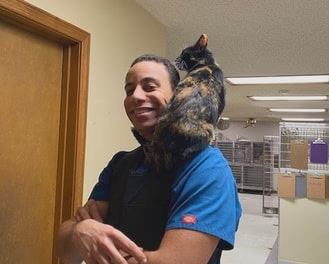10 Min Read
Ultimate Guide to Flea and Tick Seasons: Treatment & Prevention Tips
Key takeaway

Why pet owners are switching to online vet care with Dutch
-
Prescriptions delivered free to you
-
Fast access to Licensed Vets over video
-
Unlimited video visits and follow-ups
Recognizing flea and tick season is essential for maintaining the health and well-being of our beloved pets. Often, the season creeps up on owners, and they are caught wondering, “When is flea season?”. With our guide, you can stay vigilant against fleas and ticks throughout the high season and discover ways to protect your pets year-round.
Knowing when tick season happens is critical for pet owners to be vigilant, as these parasites can pose significant health risks to our furry friends. Understanding the life cycle of fleas and ticks is critical to effective prevention and treatment strategies.
So, when do fleas come out? Fleas and ticks are highly dependent on climate and location. For many states, fleas and ticks are a year-round issue, so it’s important to assess your pet’s risk based on these factors. Flea season typically starts in the spring and peaks during the warmer months of summer and early fall. During this time, fleas become more active and can quickly infest homes and pets, leading to discomfort, allergic reactions, and the transmission of diseases.
Now that we know when flea season is, when is tick season? Similarly, tick season varies depending on location and climate but generally occurs from early spring to late fall, with peak activity during warmer months. Ticks are notorious for transmitting diseases such as Lyme disease and Rocky Mountain spotted fever, making it especially important for pet owners to prevent tick infestations.1
By recognizing when fleas and ticks are most active, pet owners can take proactive measures to protect their pets.
- When Are Fleas and Ticks Most Active? A State-by-State Guide
- Preventive Measures: Protecting Your Pets from Fleas and Ticks
- The Impact of Flea and Tick Bites on Pet Health
- Home and Environment: Strategies for Flea and Tick Prevention
- FAQs
- Final Notes
When Are Fleas and Ticks Most Active? A State-by-State Guide
It's common for pet owners to ask, “When is flea and tick season?” given that the timing likely varies across states. Understanding when ticks are most active is crucial for effectively preventing and protecting pets. Flea and tick activity levels vary by state due to differences in climate and environmental factors.
Here is a state-by-state guide to help you navigate flea and tick season:2
- When is flea season in California? California flea season typically peaks in spring and summer, while ticks are most active from early spring to late fall, especially in wooded areas.
- When is flea season in Texas? Due to the warm climate, fleas can be active year-round, but peak activity occurs in spring and summer. Ticks are prevalent from early spring to late fall.
- When is flea season in New York? Flea season starts in the spring and continues through summer and fall. Ticks are most active from early spring to late fall, particularly in wooded and grassy areas.
- When is flea season in Florida? Fleas are active year-round but peak during the wet seasons. Ticks are active throughout the year, with increased activity in spring and summer.
- When is flea season in Colorado? Flea season peaks in late spring and summer, while ticks are most active from early spring to late fall, particularly in mountainous regions.
- When is flea season in Michigan? Flea season in Michigan can vary, but it typically starts in the spring and peaks during the warmer months.
Preventive Measures: Protecting Your Pets from Fleas and Ticks
When considering flea and tick prevention for your pet, choosing vet-recommended products tailored to your pet's needs is crucial. Applying vet-recommended products regularly helps repel and kill fleas and ticks before they can latch onto your pet. Credelio, NexGard, and Bravecto are popular dog flea and tick prevention medications.
When it comes to Credelio vs. Nexgard, both are popular flea and tick prevention medications for dogs, but they have some differences. Credelio provides protection for up to 30 days against fleas and ticks with a chewable, oral tablet suitable for dogs at least 8 weeks old and weighing at least 4.4 pounds. NexGard also offers 30-day protection against fleas and ticks through an orally administered chewable tablet, approved for dogs at least 8 weeks old and weighing at least 4 pounds. These medications are generally safe, but individual preferences and considerations, such as taste profile, may influence their choice.
Another popular brand is Bravecto. Between Bravecto vs. Nexgard, the key differences between them lie in their duration of effectiveness and administration method. Bravecto offers longer protection, with one oral dose providing 12 weeks of coverage against fleas and ticks, whereas NexGard offers 30 days of protection with a chewable tablet. Bravecto is available in both chewable tablet and topical solution forms, while NexGard is only available as a chewable tablet.
In addition to oral preventatives and topical treatments, consider environmental control measures such as vacuuming regularly, washing bedding in hot water, and treating outdoor areas where fleas and ticks may lurk. This comprehensive approach helps minimize the risk of infestation and keeps your pets safe year-round.
The Impact of Flea and Tick Bites on Pet Health
Flea and tick bites pose significant health risks to pets, including disease transmission and discomfort.1 Flea season for cats typically peaks in the warmer months, but indoor cats are at risk year-round due to the presence of fleas indoors. Similarly, while ticks are more active in warmer weather, dogs can still get ticks in the winter, especially in mild or indoor climates. Therefore, it's essential to maintain year-round vigilance.
Flea bites can cause skin irritation, allergic reactions, and anemia, particularly in young or small pets. In addition, fleas can transmit diseases such as tapeworms and Bartonella, commonly known as "cat scratch fever." Ticks pose additional risks since they can transmit diseases like Lyme disease and Rocky Mountain spotted fever, which can have severe consequences if left untreated.
Utilizing a telemedicine platform for pets and a Dutch membership can provide convenient access to veterinary advice and guidance, giving you timely prevention and treatment of flea and tick infestations.
Home and Environment: Strategies for Flea and Tick Prevention
Flea and tick prevention is crucial for maintaining a healthy environment for pets and humans. To prevent fleas and ticks in your home and environment, follow the tips below:
- Regularly vacuum carpets, upholstery, and pet bedding to remove eggs, larvae, and adult fleas.
- Washing pet bedding and linens in hot water can also help kill flea eggs and larvae.

FAQs
When is flea season over?
Flea activity tends to decrease in the fall as temperatures cool, but it can persist well into the winter if proper prevention measures aren't taken.
When is flea season for cats?
Flea season for cats can vary depending on geographic location and climate. In general, flea season typically starts in the spring when temperatures rise and humidity increases. Flea activity tends to peak during the warmer months of spring and summer when conditions are most favorable for their reproduction and survival.
However, fleas can be active year-round in some regions where temperatures remain mild or indoors since climate control provides a suitable environment for their survival. To that point, most people often wonder if cats can get ticks. Cats can get ticks just like dogs and other animals, so it is important to be vigilant regarding flea and tick prevention.
When do ticks come out?
Ticks are most active during warmer months, typically from early spring through late fall. However, the exact timing can vary depending on geographic location and climate conditions. Ticks generally become more active when temperatures consistently reach above freezing, typically starting in spring and peaking in summer.
When are fleas most active?
Fleas are most active during warm and humid conditions, typically in the spring and summer. They thrive in temperatures ranging from 70 to 85 degrees Fahrenheit and humidity levels of 70% or higher. However, fleas can still be active indoors throughout the year, especially in heated homes during the colder months. It's essential to maintain year-round flea prevention measures for your pets and home to control flea infestations effectively.
Do dogs get ticks in the winter?
Yes, dogs can still get ticks in winter, although their activity decreases during cold weather. Ticks may remain active throughout the year in regions where winters are mild or temperatures fluctuate. Additionally, ticks can survive in protected environments such as leaf litter or under snow cover, where they can still latch onto passing animals.
Final Notes
Understanding when flea and tick season occurs is crucial for pet owners to safeguard their beloved companions' health. Flea season typically starts in spring, peaking during warmer months, while tick season spans early spring to late fall, with peak activity in summer. Knowing the life cycle of fleas and ticks is pivotal for effective prevention and treatment, particularly with climate change affecting their activity levels.
With Dutch, fretting over flea and tick season's arrival is a thing of the past, as we have ample resources to prepare you. Dutch's telemedicine platform for pets offers convenient access to veterinary advice, ensuring timely prevention and treatment of flea and tick infestations.
Share
References
-
Cohen, Aly. “Flea and Tick Prevention.” Cornell University College of Veterinary Medicine, 1 June 2022, www.vet.cornell.edu/departments-centers-and-institutes/riney-canine-health-center/health-info/flea-and-tick-prevention.
-
Meyers, Harriet . “What Is Your State’s Flea-And-Tick Season?” American Kennel Club, https://www.akc.org/expert-advice/health/flea-tick-season/.

